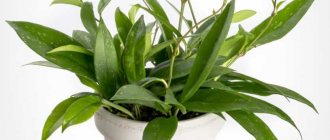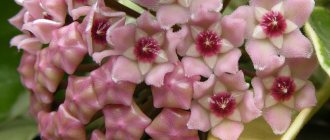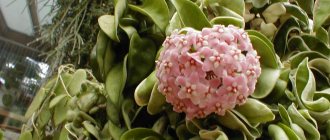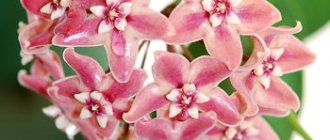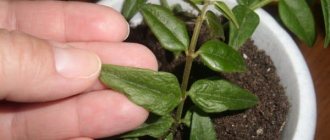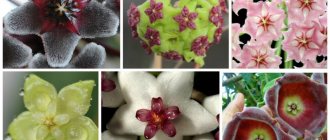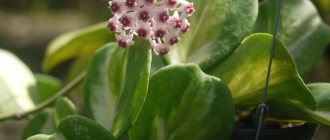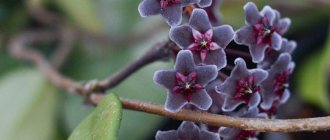MedovoeHobby.ru » Flowers » Hoya Carnosa, or fleshy - botanical description
0
101
Article rating
An exotic evergreen vine with unusual, unlike anything flowers, covered with drops of nectar - this is all Hoya Canosa. This plant is native to Polynesia and Australia and is also found in Southeast Asia. The species got its name in honor of Thomas Hoy, a British gardener and expert on rare tropical plants.
What does it look like
Hoya Carnosa belongs to the Kutrov family. Its homeland is East Asia and Australia; representatives of the Hoii genus can also be found in tropical and subtropical forests.
Hoya is a parasite because its roots penetrate the tree and feed from it. In nature, the vine can reach a length of 6 meters. The length of the leaves is from 3 to 14 cm, oval elongated shape with a pointed end.
Hoya is distinguished by beautiful sweet-smelling flowers that are collected in umbrellas
The leaves are glossy dark green, resembling satin. Hoya carnosa has long ceased to be exotic, as it is one of the most common varieties. It can be purchased in stores or at gardening centers. It is unpretentious.
Interesting! The flowers are elongated and long in shape with white petals and a star-shaped core. They smell sweet and delicious, and you can even see drops of nectar on them.
Characteristics and description
It is an evergreen flowering vine. Known as Hoya fleshy or wax ivy.
Roots
The root system of the vine is developed, grows quickly, filling the entire pot , and the hoya begins to bloom only after the pot is completely entwined with roots.
Stem
Curly, with numerous shoots. Its length can reach 10 meters.
Leaves
Fleshy, tough, pointed. Dark green, up to 8 cm in length.
Flowers and bloom
Hoya blooms in early June and blooms profusely until the end of July , then resumes flowering in the fall, in September. The flowers are star-shaped and have five petals. They are waxy, collected in dense umbrellas. Different colors: white, pink, red. They are up to 2 cm in diameter.
Smell
The flowers emit a strong, unique honey smell.
Growth rate
Grows up to 45 cm per year.
Lifespan
This is a perennial plant; it lives in a room for a long time, up to 10-15 years.
Features of care
At home, Hoya carnosa actively grows and blooms. But for this she needs to create optimal conditions of detention.
Temperature
Hoya - types and varieties, home care
In summer, the maximum permissible temperature is 24 °C. In winter it should be lowered to 16 °C. You should not lower it below 10°C, as this will cause stress to the plant.
Important! In summer, a pot of hoya can be placed on a balcony or veranda. A change in temperature is necessary so that the hoya can gain strength to form buds.
Lighting
The plant loves bright light and will feel especially comfortable in a south-facing window. Hoya is not afraid of direct sunlight and easily tolerates it.
The plant can also be located on the north window, but additional lighting is needed for flowering. Only when suitable conditions are created can you count on flowering.
Important! As soon as the buds appear, the pot cannot be moved anywhere, otherwise the hoya will drop them.
Watering
You need to water the plant after the top layer of soil has dried 2-3 cm. For this, it is better to use filtered or settled water.
Plant growth and leaf color saturation depend on watering.
In summer, 2 waterings per week are sufficient; in winter, 1 watering per week. The pot must have a drainage system, since without it moisture will stagnate. This will lead to root rot.
Spraying
Hoya grows in tropical and subtropical forests. Therefore, it needs regular spraying. To do this, it is sprayed twice a day in the summer, and once a day in the winter. In the warm season, you can give the plant a warm shower once every two weeks. To do this, it is transferred to a bath and watered with plenty of water.
Humidity
At home, Hoya carnosa needs a high level of humidity. To do this, it is sprayed and a container of water can be placed next to the pot.
In winter, it is advisable to remove hoya from heating devices, as they contribute to dry air.
Priming
It is advisable to use ready-made soil mixture for cacti and succulents. It retains moisture well, allows air to pass through and contains nutrients.
You can prepare the mixture yourself. To do this, you need vermiculite and peat in equal parts. The components are mixed and a small amount of crushed expanded clay is added.
Feeding
Caring for Hoya carnosa is easy and even a novice gardener can handle it. Fertilizing is applied only during the flowering period and for this it is better to use special products for flowering plants.
Diseases and pests. Control methods and treatment
Liana leaves can be affected by various fungi. In this case, the leaves are wiped with a damp cloth and treated with Bordeaux mixture. To prevent such diseases, Hoya should be washed in the shower as often as possible.
With excessive watering, the leaves may turn yellow, the surface of the soil may become moldy, and the roots most often begin to rot. Dark spots on the leaves may be the result of sunburn.
Of the pests for hoya, thrips and scale insects are especially dangerous. They rarely attack a plant that is regularly washed in the shower. But if this happens, then the vine must be treated with an insecticide.
- Here are some tips for caring for your hoya:
- after the buds appear, the flower cannot be turned over, it may drop the buds and not bloom;
- Hoya does not tolerate drafts;
- the flower can be grown as an ampel flower, and fixed in a pot on a support in the shape of an arch;
- in the spring, it is useful to place the hoya directly in the pot in a basin of warm water and leave it for several hours, so that the entire lump is saturated with moisture through the drainage hole;
- in winter, the hoya should be placed as far as possible from the radiators and ensure the brightest lighting possible.
Growing in open ground
Hoya flower - what the varieties Carnosa, Kerry, Bella, fleshy, Multiflora look like
In warm weather, Hoya can be planted in open ground. During this period, you need to carefully look after her. The plant is watered three times a week in the evening, fertilizing is applied twice a month.
Important! Complex mineral products should be used as fertilizer.
When pests appear, it is necessary to spray the hoya with warm water; if this does not help, then it is worth using chemicals.
As a planting site, choose a well-lit area where there are no drafts. Before wintering, the plant is dug up and transplanted into a pot.
Folk signs about the plant
Many superstitious housewives do not dare to keep ivy at home. Signs, often invented by unlucky gardeners, read as follows:
- keeping ivy at home means unsettled life;
- long shoots suck energy;
- any type of loach brings misfortune: they get rid of men in the house, spouses get divorced, and sons leave;
- toy flowers are similar to the artificial ones that are usually brought to the grave.
If believing in omens causes concern, you should know that not all indoor hoyas belong to the ivy family. You should also remember the positive folk signs of this cozy plant:
- indoor hoya flowers take away the diseases of their owners;
- the dark greenery of the plant absorbs negative energy;
- a flower is a wonderful gift as a sign of love or friendship;
- people will be drawn to the one whose ivy grows and multiplies.
In the East, it is believed that the wax tricolor brings happiness, love and good luck to the home, and also has positive energy. In addition, hoya has a number of healing properties that are often unknown to their owners:
- crushed greens of the plant will help get rid of boils;
- A paste of several leaves, oatmeal and water is an excellent remedy for purulent acne;
- Hoya leaves attached to the temples will relieve headaches.
Thus, growing exotic indoor plants that delight the eye with their beauty and sophistication has a number of useful properties and advantages. Caring for them is not very difficult, and the resulting result will be a real treasure for the owners.
When and how does it bloom
With proper care, Hoya carnosa begins to bloom profusely. It is thanks to this that it has become widespread throughout the world.
Hoya Kerry - home care
Features of flowers:
- Type: bell-shaped.
- The shape is tubular.
- The flowering period is from the beginning of June to the end of July, the next period lasts a month in September.
Not all owners immediately notice changes in the plant. Hoya carnosa begins to bud and immediately enters a sensitive state.
Important! During the flowering period, be sure to apply fertilizers, monitor the level of air humidity and prevent the flower from moving.
The necessary conditions
Among all types of hoya, Carnosa is considered the most unpretentious. It has been successfully bred in the former CIS for many decades. A minimum set of requirements, a little care - and the flower will decorate any interior.
Lighting
Hoya prefers bright light, especially during the flowering period. Its fleshy leaves are rarely burned, so you can safely hang a pot with a flower on the window. South-eastern and southern windows will be most preferable. In well-lit rooms, the plant grows well on the wall near the window.
The main rule is not to turn or rearrange the pot with hoya. The lack of light is not as terrible for her as a constant change in her position relative to its source. The plant may even drop its buds and not bloom again. For the same reason, you should not place phytolamps and other lighting next to the hoya during short daylight hours. The light source must be constant - the plant itself adapts to it.
Humidity
Hoya has thick succulent stems and leaves. It is able to accumulate moisture inside and use it later when it dries out. So the plant does not need high humidity. But on hot days you can pamper the flower with a warm shower. Precisely warm, with a water temperature of +35-38 °C. At the same time, this will be a prevention against pests.
Temperature
Hoya is thermophilic. She has no natural rest period. The plant goes into “hibernation” when the temperature drops to +16 °C and below, but the hoya does not need to rest. It can grow and even bloom all year round if there is enough warmth and light.
The ideal temperature for Hoya Myasistaya is +20-25 °C. A short-term increase to +30 will not harm the plant. But you still need to try to keep the temperature within more comfortable limits. Unlike other succulents, hoya will not tolerate winter cold. A drop in room temperature to +10 °C will destroy the plant.
Reproduction methods
There are several options for propagating Hoya carnosa. Most popular from cuttings, but can be eaten from the leaves or seeds. Each gardener chooses a convenient option himself.
Cuttings can be germinated in water or directly in soil
Reproduction methods:
- Through seeds - practically impossible at home, since the material can only be obtained in a nursery; germination is best carried out in mini-greenhouses at a temperature of 27°C.
- Through leaves is also a labor-intensive method. The cut leaf with petiole should be planted in the soil for succulents at an angle of 45 °. You can use special stimulants “Kornevin” and others.
- Through the upper shoots is the most convenient option. For him, it is enough to cut off the shoot with aerial roots. It needs to be planted in succulent soil and watered abundantly.
To speed up the formation of the root system, cover the pot with a glass jar or plastic bag.
Purchase and adaptation
Hoya is often sold with an open root system or in special shipping pots. In both cases, the flower should be immediately transplanted into a suitable substrate. Adaptation will occur in a permanent flowerpot. You cannot keep the plant in a shipping container for a long time - it will quickly die.
All newly purchased flowers need quarantine. Hoya often suffers from attacks by insect pests, so at first it needs to be protected from other indoor plants. It is better to place it in a warm, bright place so that you can carefully inspect the leaves for parasites. Preventive treatment with Fitosporin will also not hurt.
Possible problems
With proper care, Hoya carnosa grows safely at home. But if containment conditions are violated, various problems can arise.
Pests
Hoya can be affected by scale insects. It is easy to detect on the outer part of the leaf, where the bugs accumulate in the form of dense brown spots with jagged edges.
The best prevention is regular warm showers
Thrips can also appear on the plant. They look like long thin brown bugs. Insecticides must be used to kill insects.
Other problems
If there is an excess of moisture, the soil becomes moldy and the leaves turn yellow. Hoya is transplanted into new soil and pot. Dark spots are the result of a burn and the affected leaves need to be removed and the flower rearranged. Small leaves and stunted growth indicate a lack of nutrients.
Difficulties in growing large-leaved Hoya
Hoya has a strong immune system, so it rarely gets sick. Unless fungus may develop on it if the care regimen and microclimate are seriously disturbed.
In the heat, when the air is too dry, the vine can be overcome by pests - spider mites, aphids, scale insects, nematodes, mealybugs. In most cases, the plant can be cured with insecticides. But when vines are infected with a nematode, hoyas most often die. Therefore, it is recommended to take cuttings from healthy stems and root them. The rest of the plant is disposed of.
A number of problems can be dealt with with minor care adjustments:
- Spots on leaf blades are a sign of a lack or excess of sunlight.
- Slowing vine growth, shrinking and thinning of foliage signal a lack of nutrients.
- Yellowing of leaves - the air temperature in the room is too high.
- Lack of flowering - perhaps it is growing in a too cramped pot or overwintering in a warm place. Stimulation of budding is a warm shower and placing the pot in warm water for a couple of hours.
Types of flower
Based on the description of Hoya, it is easy to determine the specific variety. Among the representatives you can find plants of different shapes and colors. Such vines will be a beautiful decoration for your home.
Hoya compacta is distinguished by twisted leaves that are planted very close to each other.
Variegata has cream-colored leaves with a green edge. This variety has pink flowers. Tricolor combines the rich purple color of the leaves with a long flowering period - up to six months.
Hoya carnosa grows quickly and is easy to care for. Lianas beautifully entwine walls or special supports. With the help of such a plant you can decorate any home.
Coffee capsule Nescafe Dolce Gusto Chocochino, 3 packs of 16 capsules
1305 ₽ More details
Hot chocolate capsules Nescafe Dolce Gusto Chococino, 8 servings
334 ₽ More details
Postcards for Tatiana's Day
Types and varieties of Hoya with photos and names
Hoya is grown at home in various ways, for example:
- as ivy, twining it around a support;
- in flower pots as an hanging plant;
- like a bush with an erect stem.
To do this, gardeners choose the desired type of plant.
Hoya majestic or imperial (Hoya imperialis)
This species, represented by climbing shrubs, comes from the Malacca Peninsula. The shape of the leaf blades is oblong-oval, their apex is slightly pointed. They are smooth, leathery and large, reaching a length of 20 centimeters. Hanging umbrella-shaped inflorescences consist of 6–10 flowers, their outer surface is greenish-yellow, and the inner surface is dark red. The flowers are star-shaped and have a very pleasant aroma.
Hoya Bella
This species is represented by an ampelous plant. He is originally from India. This plant tolerates high humidity and high temperatures well when grown indoors. This not very large shrub has creeping stems covered with thickened small leaf blades sharp at the top, the length of which is about 25 mm. The medium-sized flowers are white, and their crown can be painted a unique violet-red or red color. Lush flowering lasts throughout the summer. Compared to other species, this flower has a weaker aroma; therefore, this plant can decorate almost any room.
Hoya Chlorantha
This type is distinguished by its decorative effect. The bush is decorated with elongated leaf plates, as well as velvety flowers of brown, white or pale green color.
Hoya Carnosa
This vine is very popular among gardeners. In nature, it can be found in China, Malaysia, India, Vietnam and Japan. The length of such a vine is about 6 m. When grown at home, it requires a garter or you can install a ring support around which thin stems can wrap around. The color of the flowers of such a plant depends on the variety. For example, the variety Variegata has pale pink flowers with a white border, while Tricolor has leaves with a green border, their center is red, and over time it changes its color to yellow. Hoya Exotica has foliage with a green edge and a yellow center. The Crimson Queen variety has deep pink flowers with a pinkish edge.
Hoya Motoskei
This vine reaches a length of about 6 m and has creeping, drooping shoots. The shape of the fleshy glossy leaf blades is heart-shaped or oblong, and their color is dark green. The foliage is about 80 mm long and up to 40 mm wide. White or pale beige flowers have a pink crown in the middle. They are part of the umbrella-shaped inflorescence and have a very pleasant smell.
Hoya Multiflora
This species is native to Malaysia. It is represented by ivy, the leaf blades of which are linear-oblong. Flowering begins very early. The flowers are long orange and contain narrow yellow star-shaped petals with a tip-shaped center. The most common varieties are those with large leaf blades, but there are also small ones.
Hoya Kerri
This species is also represented by ivy. It was discovered in northern Thailand in 1911 by the American scientist A. Kerry. Subsequently, it was named after this scientist. This plant is distinguished by its high decorative value. When grown indoors, its long shoots require a garter. Umbrella-shaped spherical inflorescences consist of 15–25 flowers, the surface of which has pubescence. Their color is directly related to the degree of sunlight exposure of the bush: from pale pink or lemon yellow to white with a barely visible lemon tint. The older the bush, the darker its flowers are. In this species, the leaf plates have an unusual heart-shaped shape, which is why it is also called “Valentine” or “Hoya of Lovers”. It is very easy to propagate this species; to do this, it is enough to plant one leaf blade in the substrate, and after a short time it will take root.
Hoya Lacunosa
This plant is native to Malaysia. Small leaf blades of a greenish color with a dark green border have a diamond shape. The flowers have a subtle, pleasant scent similar to perfume. This species differs from others in its ease of care and high popularity among inexperienced gardeners.
Fertilization and replanting
When the star's darling fades, it's time to think about replanting it. Please note: if you want it to bloom more often, place it in a tight pot.
Tropikanka needs fresh soil every 2-3 years. Before transferring, the pot should be disinfected, filled one-third with expanded clay and filled with fresh soil.
Ivy prefers to grow in a loose mixture of peat, sand and turf soil. Do not feed it immediately after transplanting. Fertilizers must be applied every ten to fifteen days. Suitable fertilizers for orchids and succulents.
Breeding in captivity
There are few ways to propagate a vine. But they are not complicated.
Propagation by cuttings involves dividing the main stem. Separate a part with two or three leaves and several nodes. Place in a jar of water, covering the top with foil to create a greenhouse effect.
If the apartment is warm, the container with the cuttings may not be covered. In two weeks, roots should appear. Don't let them grow too long, plant them in the ground right away.
Bindweed reproduces by stem layering. This is the simplest method, although it is not used often. Nodules with leaves and underdeveloped roots are visible on the lashes of the waxweed. When planting such a shoot, the plant will bloom in the year it was planted.
And another way is growing from seeds. Not every florist can wait for such planting material to appear.
The seeds are slightly dried, sown in soft soil and kept warm until sprouts appear. When they hatch, you need to be careful when watering: do not over-moisten the soil, but also do not dry it out.
Hoya varieties
In its homeland, in the tropics of Asia and on the coast of Australia, botanists count about 200 species. Only a few pieces are suitable for home cultivation.
Hoya Carnosa (Fleshy). The most common individual. In tropical forests they grow up to ten meters long. Her relatives are unpretentious; they have long settled in apartments and offices. Ball-shaped brushes of 20 flowers. Smells like honey.
The peculiarity of Multiflora (or multi-flowered) is that when it blooms, it cannot tolerate temperatures below 20 degrees and immediately drops its buds. The unusual pale yellow inflorescences resemble arrowheads and smell like lemon.
The Bella (or Beautiful) variety is not inferior in popularity to Myasistaya. Similar flower stalks, undemanding to heat and humidity. They exude a subtle scent of vanilla.
The Retuza vine is also called Dull. Suitable for growing as an ampelous species. The vines reach three meters. It has narrow leaves, completely uncharacteristic for hoya, and single flowers. Has a faint fragrance.
Kerry owes its name to the scientist who found it in Thailand. Round fluffy flowers are collected in 15-20 pieces.
The protruding red nectar gradually colors the petals from pink to purple. Because of its heart-shaped palms, this miracle of nature is called “Valentine”.
Compacta is not like its curly sisters. Its glossy leaves are twisted and clumsy, the colors are variegated, and the pale pink constellations are connected by a hemisphere. Blooms well in crowded conditions.
Locky. Its baskets are similar to multi-flowered. The difference is that closer to night its fragrance intensifies and resembles chocolate.
The variegated beauty Tricolor differs from its fellows not only in its unusual baskets, but also in its multi-colored foliage.
Linearis (or linear) is a hanging variety that came from the Himalayas. Elongated hanging batogs with needle-like leaves are crowned with bushes of white stars.
As a result of crossing two individuals, a new subspecies, Jennifer, was recently developed.
The uniqueness of the subspecies called Kurtisi is that its miniature leaves are much smaller than the inflorescences.
